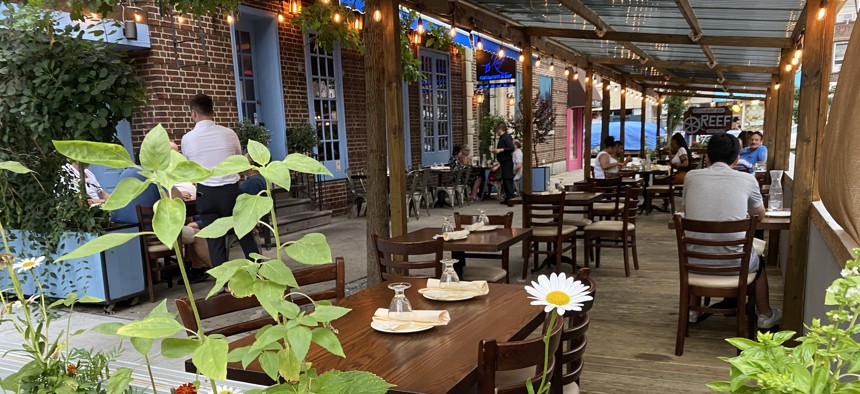What Closing Streets to Cars Meant for Restaurants in New York City

A restaurant with outdoor dining in Queens. Lindsey Nicholson/UCG/Universal Images Group via Getty Images
The city shut some streets to vehicle traffic during the pandemic. New research looks at how bars and eateries in these areas performed compared to pre-Covid years.
Restaurants and bars located along streets that New York City closed to cars during the pandemic outperformed their pre-Covid sales and fared better than eating and drinking establishments on nearby corridors that remained open to vehicle traffic.
That’s according to a new report that the city and Bloomberg Associates released on Tuesday.
In spring of 2020, the city launched two programs, Open Streets and Open Restaurants, allowing businesses in certain places to extend their dining areas into sidewalks and curb space.
Other cities around the U.S. adopted similar programs as they tried to help out businesses and provide residents with more space to socialize outdoors, where the risk of spreading Covid-19 was lower.
The new study compares sales over 18 months early in the pandemic, between March 1, 2020 and Aug. 30, 2021 to a baseline period between March 1, 2017 and Feb. 29, 2020.
It finds that restaurants along open street corridors saw sales increase by an average of 19% over pre-pandemic levels . Meanwhile, sales at nearby establishments along streets that remained fully open to traffic dropped by an average of 29% compared to the baseline.
The trends in the car-free areas are notable considering restaurant sales plummeted by more than 50% in the first three months of the pandemic, and more than 70% in Manhattan, according to the report, which was released by the city’s Department of Transportation.
Findings from the report could serve as useful data points as policy makers and others debate the extent to which outdoor dining space on streets and sidewalks should become a more widespread and permanent fixture in cities compared to the days before Covid.
The car-free corridors in New York also saw a greater share of restaurants remain open throughout the pandemic and an increase in new businesses opening. Blocks that participated in the open streets programs saw a 10% increase in new businesses, while comparable areas with regular traffic had a 20% decrease.
Over two years, the city created more than 100 miles of open streets and 12,000 restaurants self-certified as participants in Open Restaurants.
In May 2021, the City Council voted to make the Open Streets program permanent.
The transportation department is now working with stakeholders to scale up the initiative and design diverse public spaces, according to a release from the agency.
Transportation Commissioner Ydanis Rodriguez noted in a statement that in addition to offering a lifeline to many businesses that otherwise may not have survived the pandemic,“the program’s success confirms we can both sustain and grow economic vitality by reimagining the use of our public spaces.”
To read the full report, click here.
Molly Bolan is the assistant editor for Route Fifty.
NEXT STORY: Massachusetts moves from data center ‘hodgepodge’ to cloud-driven model






